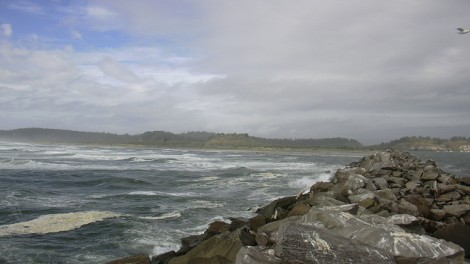ASTORIA, Ore. -- A century of wave action has eroded the jetties at the mouth of the Columbia River, leaving several sections at risk of breaching. Repairs completed over the past several years offered a quick fix for the most severely eroded sections, and kept the mouth of the river open to navigation.
The jetties ensure ship access to the river and facilitate $16 billion in commerce.
But without a $160 million to $190 million overhaul, the rock structures will continue to deteriorate and the risk of a breach will increase, according to the U.S. Army Corps of Engineers, the agency that maintains the jetties.
Additional long-term work needed to continue rebuilding the jetties and ensure they can withstand bigger waves and more frequent storms would cost between $240 million and $280 million.
The Corps is still at least two years away from starting the rebuilding project, which has yet to be approved, according to Project Manager Laura Hicks.
At a public information meeting Wednesday night in Astoria, Hicks presented the repair options as outlined in the project's environmental assessment. The proposal still needs presidential approval and congressional funding, and it is open to public comment until Feb. 12.
The North and South jetties were built from 1885 to 1917, realigning the entrance to the Columbia River, and establishing a more reliable navigation channel. They were modified from 1930 to 1942, and Jetty A and the Sand Island pile dikes were added near Baker Bay to protect the North Jetty during ebb tides.
Repairs were made in 1965 for the North Jetty, in 1962 for Jetty A, and in 1982 for the South Jetty. Additional repairs to address immediate needs were completed at the North Jetty in 2005 and at the South Jetty in 2007.
But there are some portions of the jetties that have never had work done on them since they were built, said Hicks. We're looking at how these structures perform and what we should do in the future to maintain them.
Hicks explained the options for bolstering the structures, basically capping the jetties with new rock and adding spur groins to protect the rock by diverting current and reducing scouring of the underlying foundation. The Corps is considering options for starting the work, including a staggered construction schedule that would complete work as needed.
The base of the 6.5-mile South Jetty, which separates Trestle Bay from the Pacific Ocean, is a weak point that needs to be supported, said Hicks. The Corps is proposing scheduled repairs of the structure to add above-water stability, adding five spur groins to stabilize the foundation and placing sand or cobbles at the shore to protect the base against further erosion.
The repairs would take place in three major actions from 2013 to 2030. The South Jetty has receded approximately 6,200 feet in length since original construction, and without rebuilding will continue to deteriorate at a rate of 5 to 20 feet per year.
Loss of jetty length would contribute to continued loss of the underwater shoal, exposing the South Jetty to increasing wave action and the shoreline at the root of the jetty to higher wave forces.
The shoreline would continue to erode and recede, resulting in a shoreline breach into Trestle Bay in about 8 to 16 years.
Modeling suggests that in 50 years, the South Jetty may breach as many as 6 times at multiple locations, which would destabilize the jetty and allow sand to move through it.
The Corps is proposing to add four spur groins to the two-mile-long North Jetty, capping the head of the jetty with additional rock and using fill material to stop erosion at the base of the structure.
The North Jetty has receded approximately 2,100 feet in length since its construction, and without rebuilding, the head of the jetty will continue to deteriorate at a rate of about 20 to 50 feet per year. Modeling shows that in 50 years, the North Jetty may breach as many as 6 times at multiple locations.
The Corps is accepting comments on its rehabilitation proposal.
Read the draft environmental assessment detailing the project and the anticipated impacts.
Information from: The Daily Astorian


